by Joe Mandese @mp_joemandese
Source: www.mediapost.com, February 2023
At a time when many big marketers and agencies are shifting ad budgets from legacy media like television to digital platforms, including mobile, is anyone asking which ones are more effective ad media? Apparently, the researchers at Neuromarketing Research firm MediaScience have, and guess what they found? TV still is more effective.
At least that’s what the MediaScience study, commissioned by TV giant Comcast found, according to a report published this week by Media Dynamics.
The study, based on a sample of 188 people, split them into two groups: one using their mobile phone to watch content from YouTube and Facebook containing 30-second ads; and another watching :30s via traditional TV or streaming content.
Using biometric measurement including eye-tracking, heart rate and sweat detectors, MediaScience found TV viewers saw more of the ads, watched a greater percentage of the ads they saw, and had more than twice the degree of unaided recall than the people who watched them on their mobile devices.
“As the accompanying table shows, 94% of the TV viewers saw the commercial that was presented twice in the content they were watching and 71% of the ad message’s content was seen,” Media Dynamics noted, adding, “This yielded an average unaided recall level of 44% (although it is not exactly clear whether the viewer had to prove exposure by describing what was seen). In contrast, only 64% of the mobile viewers saw the average commercial and those who did see the ad viewed only 30% of its content. This yielded an average unaided recall score of 20%, less than half the corresponding number for TV.”
To be fair, Media Dynamics says “it may be unrealistic” to compare 30-second ads viewed on mobile devices to watching them on TV, “due to the lower attention spans of such audiences.
“A fairer comparison might have been :15s for both TV and mobile.”

